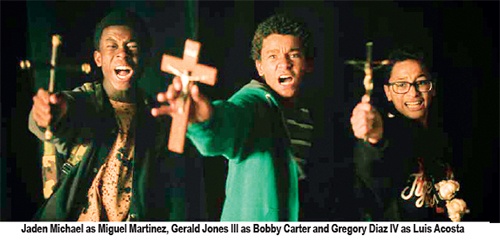Features
Quirky allegory on class tensions

Vampires vs. the Bronx drives the stake through the heart of real problems such as xenophobia and gentrification
By Tharishi Hewavithanagamage
With Halloween coming around the corner, ‘Vampires vs. the Bronx’ is one of the latest additions to Netflix’s line of horror-comedy movies. Directed by Oz Rodriguez, who co-wrote the script with Blaise Hemingway, ‘Vampires vs. the Bronx’ flips the table on Bram Stoker’s classic tale ‘Dracula’ that has been retold many times. Netflix’s latest film rewrites the tale as a quirky allegory on class tensions and the systematic repression in communities of color through gentrification. It’s a refreshing update seeing as it is also more kid-friendly and kid-centric.
Bloodsucking monsters have existed in mythology for centuries, but Bram Stoker’s Dracula popularized the modern conception of a vampire. Stoker’s Dracula was portrayed as a foreigner from the then-strange land of Eastern Europe, bent on using his wealth to expand his empire and in hindsight, his dinner options. The tale as old as time has been retold in many different ways, with many movies almost always focusing on the sexual aspect of Stoker’s Dracula. The seduction of the innocent, and the sexual liberation of women have been the focal point of many plotlines. While movies like ‘Blade’ showcased a more hyper-violent aspect.

The film is roughly one hour and twenty minutes and it spends no time allowing the characters to breathe, which works in favor of the movie. Director by Oz Rodriguez attempts to keep the story flowing at a steady pace. It’s also evident that the film is more interested in keeping up with the characters than character development. The style and approach comes as comfortable, quick comedic moments than big action sequences like in ‘Blade,’ which the kids actually refer to before they go hunting for vampires.
The plot is simple and easy to follow, as the main focus is on a few kids who aren’t anywhere close to being expert vampire hunters, which makes the story unique in its own way, in comparison to the big blockbuster monster movies that enter the big screen every now and then. Another salient feature is the mix of traditions and cultures in the Bronx, shown at every opportunity, like the Latin households being equipped with materials generally required for vampire hunting, such as garlic and crucifixes.
Nearly all the characters use Spanish phrases every now and then, which adds to the overall authenticity of the film while painting an image of the Bronx, as a unique place worth safeguarding.
The kids make for a whimsical group that keeps the comedy flowing throughout the movie and the supporting cast involved in the film, from Zoe Saldana to Wu-Tang Clan’s Method Man, play short roles, but eventually add up to make the film what it is. Another memorable duo are Chris Redd and Vladimir Caamaño, who play two guys offering snappy commentary on everything going on around them. The vampires look like they walked off the set of the ‘Underworld’ franchise and are portrayed as the usual bloodsucking monsters, working in real estate this time.
Stoker’s story about Dracula stands as a metaphor for the parasitic ways of the upper class, and it has never been more relevant in today’s socially cognizant age. The film draws on Stoker’s idea of Dracula, who was trying to purchase property in London so he can maintain a steady supply of food, but in this case turns these bloodsuckers into slimy businessmen, bent on gaining power and influence and procuring a feasting ground in the process. As symbols of modern day gentrification, the vampires are quite literally sucking the blood out of the Bronx.
With lines like “White people with canvas bags — that’s always the first sign!” Rodriguez openly enjoys poking fun at the signs of gentrification, and the trends that signal something darker for the locals. Many of the adult characters also constantly refer to the Bronx as “somewhere where no one cares when people disappear,” which jabs at the fact that this community of color is usually not cared for by people outside it and that idea has become routine.
The director makes the message very clear from the beginning of the movie, and has no intentions of sugar coating it. It’s a witty way of looking at and spreading the message regarding xenophobia and gentrification in the current context. The film also weaves in another social issue; gang violence, using Bobby, and how the entire neighborhood expects Bobby to end up like his father, a victim of gang violence. Vampires vs. the Bronx is a simple, colorful movie filled with gags, conveying a deep message through every frame. It may not re-invent existing vampire lore, but it drives the stake through the heart of real problems while keeping the fun going.